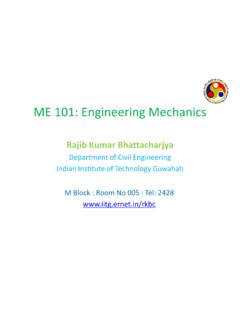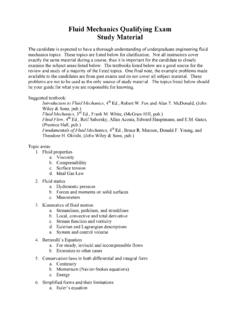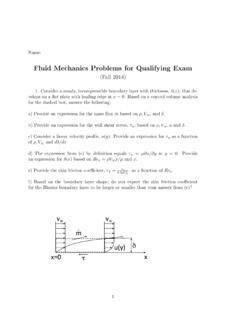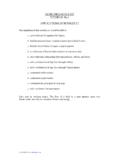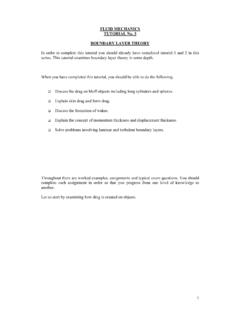Transcription of Unit 41: Fluid Mechanics
1 1 Unit 41: Fluid Mechanics Unit code: T/601/1445 QCF Level: 4 Credit value: 15 OUTCOME 1 STATIC Fluid SYSTEMS TUTORIAL 1 - HYDROSTATICS 1. Be able to determine the behavioural characteristics and parameters of static Fluid systems Immersed surfaces: rectangular and circular surfaces retaining walls, tank sides, sluice gates, inspection covers, valve flanges Centre of pressure: use of parallel axis theorem for immersed rectangular and circular immersed surfaces Devices: hydraulic presses; hydraulic jacks; hydraulic accumulators; braking systems; determine outputs for given inputs On completion of this tutorial you should be able to do the following. Define the main fundamental properties of liquids. Explain and calculate hydrostatic pressure. Calculate the hydrostatic forces and moments on submerged surfaces.
2 Explain and solve problems involving simple hydrostatic devices. Before you start you should make sure that you fully understand first and second moments of area. If you are not familiar with this, you should do the pre-requisite tutorial preceding this one. Let s start this tutorial by studying the fundamental properties of liquids. 2 1. SOME FUNDAMENTAL STUDIES IDEAL LIQUIDS An ideal liquid is defined as follows. It is INVISCID. This means that molecules require no force to separate them. The topic is covered in detail later. It is INCOMPRESSIBLE. This means that it would require an infinite force to reduce the volume of the liquid. REAL LIQUIDS VISCOSITY Real liquids have VISCOSITY. This means that the molecules tend to stick to each other and to any surface with which they come into contact.
3 This produces Fluid friction and energy loss when the liquid flows over a surface. Viscosity defines how easily a liquid flows. The lower the viscosity, the easier it flows. BULK MODULUS Real liquids are compressible and this is governed by the BULK MODULUS K. This is defined as follows. K = V p/ V p is the increase in pressure, V is the reduction in volume and V is the original volume. DENSITY Density relates the mass and volume such that = m/V kg/ m3 PRESSURE Pressure is the result of compacting the molecules of a Fluid into a smaller space than it would otherwise occupy. Pressure is the force per unit area acting on a surface. The unit of pressure is the N/m2 and this is called a PASCAL. The Pascal is a small unit of pressure so higher multiples are common.
4 1 kPa = 103 N/m2 1 MPa = 106 N/m2 Another common unit of pressure is the bar but this is not an SI unit. 1 bar = 105 N/m2 1 mb = 100 N/m2 GAUGE AND ABSOLUTE PRESSURE Most pressure gauges are designed only to measure and indicate the pressure of a Fluid above that of the surrounding atmosphere and indicate zero when connected to the atmosphere. These are called gauge pressures and are normally used. Sometimes it is necessary to add the atmospheric pressure onto the gauge reading in order to find the true or absolute pressure. Absolute pressure = gauge pressure + atmospheric pressure. Standard atmospheric pressure is bar. 3 2. HYDROSTATIC FORCES When you have completed this section, you should be able to do the following. Calculate the pressure due to the depth of a liquid.
5 Calculate the total force on a vertical surface. Define and calculate the position of the centre of pressure for various shapes. Calculate the turning moments produced on vertically immersed surfaces. Explain the principles of simple hydraulic devices. Calculate the force and movement produced by simple hydraulic equipment. HYDROSTATIC PRESSURE PRESSURE INSIDE PIPES AND VESSELS Pressure results when a liquid is compacted into a volume. The pressure inside vessels and pipes produce stresses and strains as it tries to stretch the material. An example of this is a pipe with flanged joints. The pressure in the pipe tries to separate the flanges. The force is the product of the pressure and the bore area. WORKED EXAMPLE No. 1 Calculate the force trying to separate the flanges of a valve ( ) when the pressure is 2 MPa and the pipe bore is 50 mm.
6 SOLUTION Force = pressure x bore area Bore area = D2/4 = x = x 10-3 m2 Pressure = 2 x 106 Pa Force = 2 x 106 x x 10-3 = x 103 N or kN 4 PRESSURE DUE TO THE WEIGHT OF A LIQUID Consider a tank full of liquid as shown. The liquid has a total weight W and this bears down on the bottom and produces a pressure p. Pascal showed that the pressure in a liquid always acts normal (at 90o) to the surface of contact so the pressure pushes down onto the bottom of the tank. He also showed that the pressure at a given point acts equally in all directions so the pressure also pushes up on the liquid above it and sideways against the walls. Fig. 2 The volume of the liquid is V = A h m3 The mass of liquid is hence m = V = Ah kg The weight is obtained by multiplying by the gravitational constant g.
7 W = mg = Ahg Newton The pressure on the bottom is the weight per unit area p = W/A N/m2 It follows that the pressure at a depth h in a liquid is given by the following equation. p = gh The unit of pressure is the N/m2 and this is called a PASCAL. The Pascal is a small unit of pressure so higher multiples are common. WORKED EXAMPLE 2 Calculate the pressure and force on an inspection hatch m diameter located on the bottom of a tank when it is filled with oil of density 875 kg/m3 to a depth of 7 m. SOLUTION The pressure on the bottom of the tank is found as follows. p = g h = 875 kg/m3 g = m/s2 h = 7 m p = 875 x x 7 = 60086 N/m2 or kPa The force is the product of pressure and area. A = D2/4 = x = m2 F = p A = x 103 x = x 103 N or Kn 5 PRESSURE HEAD When h is made the subject of the formula, it is called the pressure head.
8 H = p/ g Pressure is often measured by using a column of liquid. Consider a pipe carrying liquid at pressure p. If a small vertical pipe is attached to it, the liquid will rise to a height h and at this height, the pressure at the foot of the column is equal to the pressure in the pipe. This principle is used in barometers to measure atmospheric pressure and manometers to measure gas pressure. Barometer Manometer In the manometer, the weight of the gas is negligible so the height h represents the difference in the pressures p1 and p2. p1 - p2 = g h In the case of the barometer, the column is closed at the top so that p2 = 0 and p1 = pa. The height h represents the atmospheric pressure. Mercury is used as the liquid because it does not evaporate easily at the near total vacuum on the top of the column.
9 Pa = g h WORKED EXAMPLE A manometer ( ) is used to measure the pressure of gas in a container. One side is connected to the container and the other side is open to the atmosphere. The manometer contains oil of density 750 kg/m3 and the head is 50 mm. Calculate the gauge pressure of the gas in the container. SOLUTION p1 - p2 = g h = 750 x x = Pa Since p2 is atmospheric pressure, this is the gauge pressure. p2 = Pa (gauge) 6 SELF ASSESSMENT EXERCISE 1. A mercury barometer gives a pressure head of 758 mm. The density is 13 600 kg/m3. Calculate the atmospheric pressure in bar. ( bar) 2. A manometer ( ) is used to measure the pressure of gas in a container. One side is connected to the container and the other side is open to the atmosphere.
10 The manometer contains water of density 1000 kg/m3 and the head is 250 mm. Calculate the gauge pressure of the gas in the container. ( kPa) 3. Calculate the pressure and force on a horizontal submarine hatch m diameter when it is at a depth of 800 m in seawater of density 1030 kg/m3. ( MPa and MN) 7 3. FORCES ON SUBMERGED SURFACES TOTAL FORCE Consider a vertical area submerged below the surface of liquid as shown. The area of the elementary strip is dA = B dy You should already know that the pressure at depth h in a liquid is given by the equation p = gh where is the density and h the depth. In this case, we are using y to denote depth so p = gy The force on the strip due to this pressure is dF = p dA = B gy dy The total force on the surface due to pressure is denoted R and it is obtained by integrating this expression between the limits of y1 and y2.










